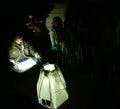Portable Light prototype designs from the Nomads & Nano-Materials Project at the University of Michigan were exhibited at Nextfest 2005 in Chicago, where leading R&D labs, companies and visionary innovators from around the world gather to show their work.
The light-emitting textile designs have been developed by the Project for the nomadic Huichol (Wirrárica) people of the remote Mexican Sierra Madre Mountains. Portable Light applies creative processes and strategic thinking to optimize the performance of existing semiconductor technologies and create new applications to serve the large number of people - more than 2 billion - who do not have access to electric light or power.
The designs are completely self-contained, portable, off-the-grid light engines that can be deployed at a global scale wherever energy-efficient electrical power and illumination are needed.
Among the prototypes are a portable workshop; a community power bag, a portable, folding reading stool and a portable reading mat. Try on a light emitting garment that is a wearable workshop, roll up a reading light, sit on a folding stool that creates its own light, or pick up a portable power plant that weighs less than four pounds.
“By developing a new material medium for digital light, the Nomads project demonstrates the advantages of an energy-efficient textile lighting infrastructure,” says Kennedy. “The prototypes produced by our research group are lightweight and easy to ship and transport [and] offer the production economies of large-run textile fabrication.”
Opportunities for participation
KVA is looking for industrial manufacturers with expertise in LED and photovoltaic technology who are willing to donate money or components to the Portable Light Project's sites in developing communities (e.g. Mexico's Huichol community).
According to the Portable Light Project website, "Manufacturers that support the Portable Light Project are industry leaders who take action for the greater good and gain valuable product performance data on weather resistance, UV penetration, electrical output and duty cycles for solid state and polymer technologies. [They] benefit from real world knowledge building in key issues of thermal management, charge control design, light output and optics generated by the Portable Light Project."









